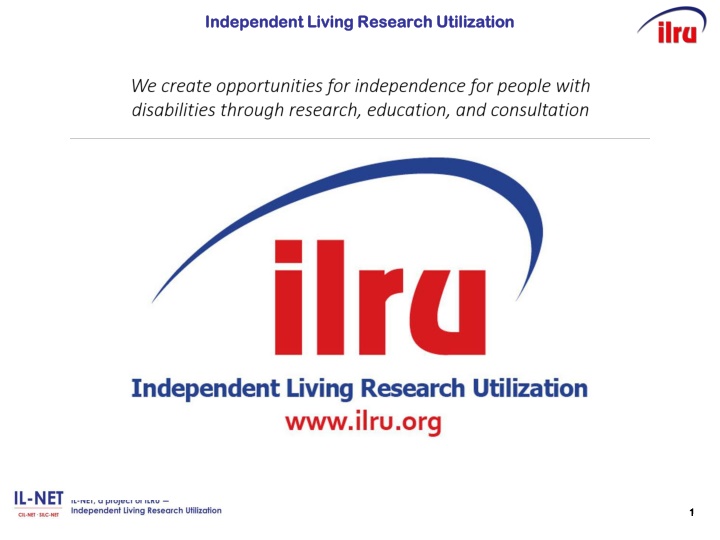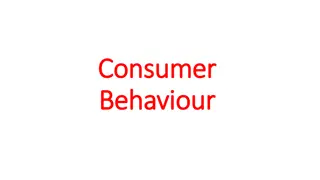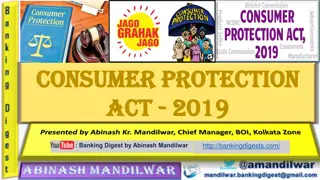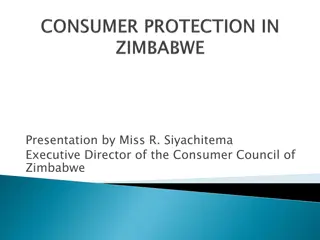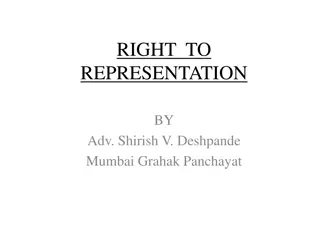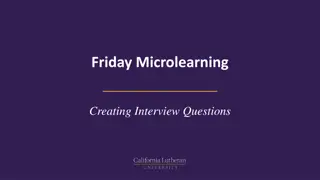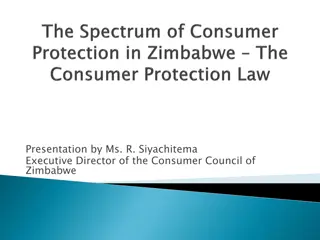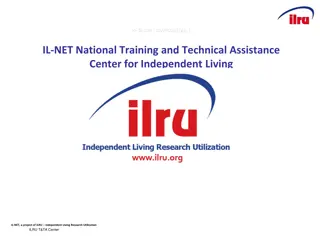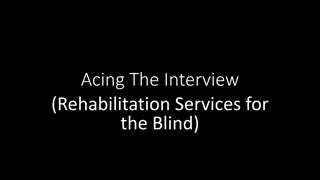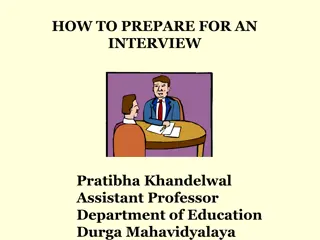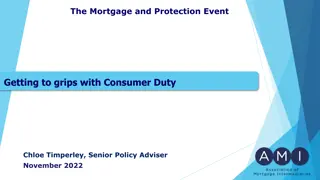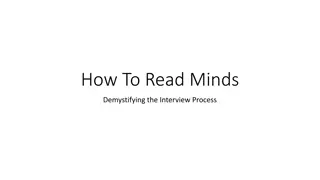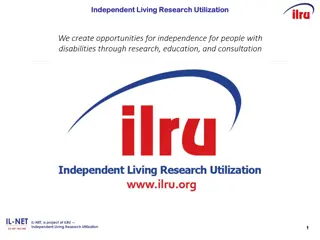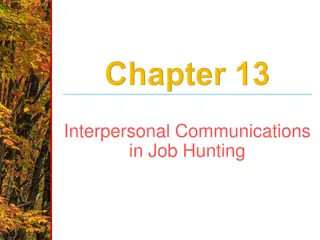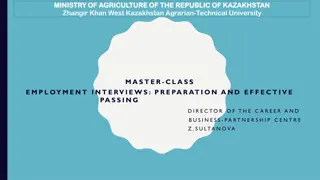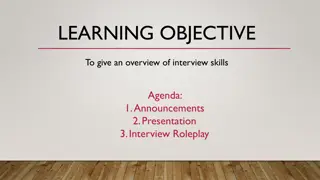Importance of Initial Consumer Interview in Independent Living Research
The initial interview in Independent Living Centers plays a crucial role in introducing consumers to the IL Philosophy, determining eligibility for services, establishing peer-to-peer relationships, and empowering individuals to engage in consumer-driven dialogue. It aids in identifying needs, goals, services, potential barriers, and developing Independent Living Plans. Misinterpretation or inaccurate recording of consumer information during this stage can lead to loss of eligibility and oversight of at-risk status.
Download Presentation

Please find below an Image/Link to download the presentation.
The content on the website is provided AS IS for your information and personal use only. It may not be sold, licensed, or shared on other websites without obtaining consent from the author.If you encounter any issues during the download, it is possible that the publisher has removed the file from their server.
You are allowed to download the files provided on this website for personal or commercial use, subject to the condition that they are used lawfully. All files are the property of their respective owners.
The content on the website is provided AS IS for your information and personal use only. It may not be sold, licensed, or shared on other websites without obtaining consent from the author.
E N D
Presentation Transcript
Independent Living Research Utilization Independent Living Research Utilization 1 1
Get to the Core of It: Get to the Core of It: Integrating CIL Core Services for a Integrating CIL Core Services for a Holistic Consumer Experience Holistic Consumer Experience Incorporating Discussions of Empowerment and Incorporating Discussions of Empowerment and Self Self- -Advocacy with Consumers at Initial Contact Advocacy with Consumers at Initial Contact Presenters: Presenters: Darrel Christenson Darrel Christenson Michelle Crain Michelle Crain May 1, 2018 May 1, 2018 Tempe, AZ Tempe, AZ 2
Importance of Initial Consumer Interview and Importance of Initial Consumer Interview and Key Elements of Motivational Interviewing Key Elements of Motivational Interviewing Michelle Crain Michelle Crain 3
Importance of Initial Interview Importance of Initial Interview The initial intake/interview can be a transformative experience for consumers and can define their relationship with Centers for Independent Living (CILs) and success going forward. Therefore, the initial interview is important for several reasons: 1. It is the CIL s first in-depth opportunity to introduce consumers to the Independent Living (IL) Philosophy. 2. It is during this time that eligibility for CIL services is determined. 3. It sets the stage for establishing a peer-to-peer relationship with IL staff. 4
Importance of Initial Interview, Importance of Initial Interview, cont d. cont d. 4. It is the initial process by which individuals are empowered to engage in extensive consumer- driven dialogue with IL staff. 5. It serves as a forum to assist consumers in discovering and utilizing their strengths to establish and later achieve their goals. 6. If well-structured, it helps the consumer and IL staff to comprehensively identify needs, goals, services, and any potential barriers, in the development of the consumer s Independent Living Plan (ILP). 5
Importance of Initial Interview, Importance of Initial Interview, cont d. 2 cont d. 2 7. It is during the initial interview when consumers disclose information that is essential to establishing eligibility and identifying needs, goals, services, and potential barriers to community living. If this information is misinterpreted or recorded inaccurately due to IL staff s distractions and poor listening skills, it may result in: Loss of eligibility Oversight of consumer s at-risk status (if the desired outcome is avoiding institutionalization) 6
Importance of Initial Interview, Importance of Initial Interview, cont d. 3 cont d. 3 Oversight of the antecedents related to consumer s placement in an institutional setting from which they wish to transition A poorly devised ILP 7
Motivational Interviewing Motivational Interviewing What is Motivational Interviewing (MI)? MI is a practice based on the work of psychologists, William R. Miller and Stephen Rollnick. MI can be applied to numerous fields of work (including independent living) that are engaged in discussions about change or achieving goals. In its relation to IL, MI is a collaborative consumer- driven communication strategy that strengthens a consumer s own commitment and motivation to reach his or her goals. 8
Fundamental Applications of MI to IL Fundamental Applications of MI to IL MI encourages IL staff and consumers to think more holistically about the consumer s current life situation and the direction(s) the consumer wishes to explore to achieve a desired outcome. Similar to MI, IL promotes good interviewing techniques that include: Active/Reflective Listening Focus attentively on what the consumer is saying; summarize understanding of what was said to consumer; probe for clarification, and maintain an effective balance between listening and note-taking. 9
Good Interviewing Techniques Good Interviewing Techniques Note-taking Establish a method, through forms the CIL s data collection program and other acceptable means, to capture pertinent information for establishing eligibility, goals, services, etc. Asking open-ended questions Allow for a more in- depth discussion that builds empathy and serves as a basis for the ILP. 10
Motivational Interviewing Employs Motivational Interviewing Employs Positive Approaches Positive Approaches MI employs a Strengths-Based Approach, whereby consumers are encouraged to focus on their strengths, but not at the exclusion of addressing concerns or barriers. MI promotes a Solution-Focus Approach that entails framing or describing a situation from a positive perspective versus a negative perspective. MI is a skill in which IL staff can become proficient, but only through experience gained through ongoing practice. Online courses and demonstration videos may be helpful as well. 11
Motivational Interviewing Consists of Motivational Interviewing Consists of Four Processes Four Processes According to Miller and Rollnick (2013), there are four processes of MI all of which have implications to IL: 1. Engaging: the process of establishing a mutually trusting, and respectful helping relationship. 2. Focusing: clarifying a particular goal or direction for change. 3. Evoking: eliciting the person s own motivation for particular change. 4. Planning: developing a specific change plan to implement. 12
Motivational Interviewing Motivational Interviewing T3 T3 T3 (http://us.thinkt3.com/motivational-interviewing- changing-the-conversation) is an online resource that illustrates the standard interviewing approach vs. the MI approach, which is more consistent with the IL Philosophy: Standard Approach: Focuses on advising, warning and persuading vs. MI Approach: Emphasizes personal choice and autonomy. Standard Approach: Focuses on fixing the problem vs. MI Approach: Focuses on person s concerns. 13
Standard Approach vs. MI Approach Standard Approach vs. MI Approach Standard Approach: Paternalistic relationship vs. MI Approach: A collaborative partnership. Standard Approach: Ambivalence seen as being in denial vs. MI Approach: Ambivalence seen as a normal part of the change process. Standard Approach: Assumes person is motivated to change vs. MI Approach: Matches approach with the person s level of readiness to change. 14
Motivational Interviewing has Motivational Interviewing has Expanded Beyond Field of Counseling Expanded Beyond Field of Counseling MI is not a recent concept, but has expanded beyond the field of counseling into multiple disciplines. It contains a set of principles, techniques and strategies that go beyond the scope of this training. For additional sources of information, check out: https://www.youtube.com/watch?v=E6DYYJJJpLo http://us.thinkt3.com/courses-offerings/motivational- interviewing-facilitating-change http://www.ncjfcj.org/sites/default/files/MI%20Strate gies%20%26%20Techniques%20- %20Rationales%20and%20examples.pdf 15
Introduction to the Introduction to the Critical Role of Information & Referral (I&R) Critical Role of Information & Referral (I&R) Darrel Christenson Darrel Christenson 16
Information & Referral Information & Referral The Gateway to Your CIL to Your CIL I&R is the first point of contact to the outside world A core service & the first impression of your CIL Large or small critical role/ staff Answer the phone and follow-up You are the first agency to call me back Do not give people the run around internally or externally The Gateway 17
I & R I & R Your Gateway Your Gateway Information is knowledge & resources = Power I&R opens up your CIL to its other services Peer Mentoring, IL Skills Instruction, Advocacy etc. Let them know you will work WITH them, not FOR them. Empowers caller. IL Philosophy not Medical Model 18
Seamless Services Seamless Services Ability360 Holistic Approach to providing services Much more difficult to work this way Much better service delivery Large/ small, rural or urban, work outside silos Ability360 19
Seamless Services Seamless Services Ability360 Ability360 All services truly are interconnected One staff = 1 or more programs IL Philosophy no handholding/ babysitting Remember to think of the whole person 20
CIL CIL- -NET Attribution NET Attribution Support for development of this technical assistance information was provided by the Department of Health and Human Services, Administration for Community Living under grant number 90ILTA0001. No official endorsement of the Department of Health and Human Services should be inferred. Permission is granted for duplication of any portion of this information, providing that the following credit is given to the project: Developed as part of the CIL-NET, a project of the IL- NET, an ILRU/NCIL/APRIL/USU-CPD National Training and Technical Assistance Program. 21
